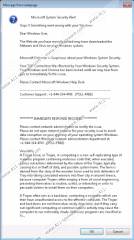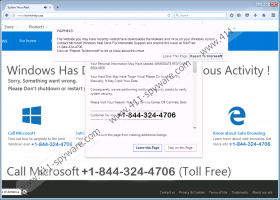Call Windows Help Desk Immediately Tech Support fake alert Removal Guide
If you happen to encounter the Call Windows Help Desk Immediately Tech Support fake alert, you must know that this warning message has been crafted by cyber crooks so they could profit illegally from unsuspecting internet users. Unfortunately, seeing this error message while surfing the web could indicate a presence of a dubious program on your operating system. Thus, we highly advise you to check your computer for questionable software. To understand where the fake alert comes from and how it could be dangerous, be sure to read the rest of our detailed report. In addition to such critical information, we provide a few virtual security tips coming from our malware experts. Below you will also find a generic removal guide that should help you delete a program responsible for the Call Windows Help Desk Immediately Tech Support fake alert.
You could encounter the Call Windows Help Desk Immediately Tech Support fake alert in a few different ways. Upon further analysis, our research team has discovered that in quite a few cases users come across this suspicious warning message via a redirect. This means that you could have clicked on a questionable ad, pop-up, or coupon which has been implemented with a redirect link leading to a site that hosts the devious warning message. In such a case be sure to close your web browser as soon as possible. If you are seeing the bogus error message every single time you start your web browser, it might be an indication that a suspicious third-party application is fully active on your operating system. It goes without saying that such functionality of a dubious program can ruin your online experience. The fake alert itself informs you that there is a virus active on your personal computer. Due to this, your personal data might be exposed to suspicious third-parties. You are asked to call a toll-free number for further instructions. The error is designed in a way to resemble an authentic Microsoft warning; this is used as a scare tactic. Keep in mind that a legitimate Microsoft alert would never urge you to call any specific number. Under no circumstances follow the requests made within the bogus message as cyber crooks will likely try to lure money from your for a hoax repair procedure. Make sure not to waste any time and delete the application associated with Call Windows Help Desk Immediately Tech Support fake alert. This way you will be able to surf the web without major interruptions once again.
It is important to take precautionary measures to keep your operating system fully secure at all times. Firstly, you need to realize that practicing safe browsing is a crucial to you overall virtual security. Make sure to bypass all suspicious ads, pop-ups, or coupons as they could lead you to questionable and even potentially dangerous websites. Furthermore, you must stay away all dubious download sites because they are infamous for hosting software bundles, which are often employed by cyber crooks to spread their devious programs. Avoid questionable setup files by simply obtaining your software from its official developer's websites only as they can be considered trustworthy. It is also important to pay as much attention as possible to every single installation procedure as you could be presented with a chance to cancel the installation of some unwanted third-party program by simply unmarking a single box. While all of this will improve your virtual security, you must know that your best bet to keep your computer safe and secure at all times is by running a professional antimalware tool. Be sure to install such a tool if you do not have one already.
The instructions that we provide below will allow you to delete a program linked to Call Windows Help Desk Immediately Tech Support fake alert in just a few simple steps. Be sure not to skip any steps as that could lead to an incomplete removal. This is a situation that you do not want to find yourself in, as dubious programs might be able to restore themselves using their traces. To be sure that the termination procedure has been successful, make sure to double-check your computer for any suspicious files or registry entries right after you are done with the instructions below.
How to remove a program linked to Call Windows Help Desk Immediately Tech Support fake alert
Google Chrome
- Start your web browser.
- Click the Chrome Menu button select Settings.
- Click Extensions.
- Click the Trash can icon next to the unwanted extension.
- Select Remove to confirm your choice.
Mozilla Firefox
- Open your web browser.
- Click the Menu button and select Add-ons.
- Select Extensions.
- Click the Remove button next to the suspicious extension to remove it.
Internet Explorer
- Launch your web browser.
- Click the Menu button and select Manage add-ons.
- Select Toolbars and Extensions.
- Locate the unwanted extension and click Remove.
How to reset your web browser
Google Chrome
- Start your web browser.
- Click the Chrome Menu button and select Settings.
- Click Show advanced settings and select Reset settings.
- Click Reset to confirm your choice.
Mozilla Firefox
- Launch your web browser.
- Select the Menu button.
- Click the question mark icon at the bottom.
- Select Troubleshooting Information.
- Click Refresh Firefox.
- Click Refresh Firefox to confirm your choice.
Internet Explorer
- Open your web browser.
- Click the Menu button.
- Select Internet Options.
- Select the Advanced tab.
- Click the Reset option.
- Check Delete personal settings and then click the Reset button.
- Click Close.
Call Windows Help Desk Immediately Tech Support fake alert Screenshots:



